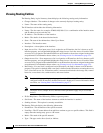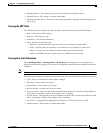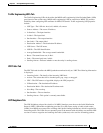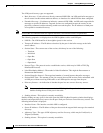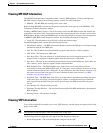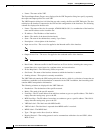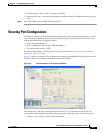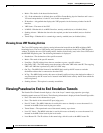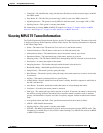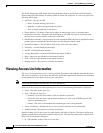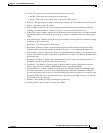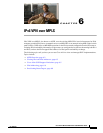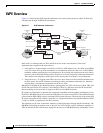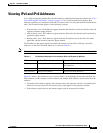
5-12
Cisco Active Network Abstraction 3.6.6 MPLS User Guide
OL-19192-01
Chapter 5 Viewing MPLS Logical Inventory
Viewing Pseudowire End-to End Emulation Tunnels
• Mask—The details of the dotted decimal mask.
• VC—If the subinterface is defined above an ATM or Frame-Relay physical interface and it uses a
VC-based encapsulation, it is the VC used in this encapsulation.
• IP Interface—A hyperlink that displays the VRF properties in the inventory window for the IP
interface.
• VRF Name—The name of the VRF.
• Is MPLS—Whether this is an MPLS interface, namely, enabled (true) or disabled (false).
• Sending Alarms—Whether the alarm for the required port has been enabled (true) or disabled
(false).
• Tunnel Edge—Whether this is a tunnel edge, namely, enabled (true) or disabled (false).
Viewing Cross VRF Routing Entries
The Cross VRF routing entries display routing information learned from the BGP neighbors (BGP
knowledge base). The cross VRF routing entry parameters are displayed in the Cross VRF Properties
window. To display the cross VRF routing entries, double-click an entry (row) in the Cross VRFs tab of
the MP BGP Properties pane. The following information is displayed:
• Destination—The destination of the specific network.
• Mask—The mask of the specific network.
• Next Hop—The PE address from where to continue to get to a specific address.
• Out Going VRF—The VRF routing entry that points to the other VRF in the same PE. The outgoing
VRF is the VRF that is pointed to by the Cross VRF entry.
• Out Tag—The MPLS label inserted in the MPLS label stack by this PE router to reach the
destination address that is connected to the other VRF.
• In Tag—The MPLS label used by this router to identify traffic arriving at the destination address, it
was advertised by this PE router and is inserted in the MPLS label stack by the PE from which the
traffic originated.
• Sending Alarms—This option is currently unavailable.
Viewing Pseudowire End-to End Emulation Tunnels
The Pseudo Wire Tunnels branch displays a list of the Layer 2 tunnel edge properties (per edge),
including tunnel status and VC labels. The following information is displayed in the Tunnel Edges table:
• Port—The name of the subinterface or port.
• Peer—The details of the selected LCP peer (edge peer).
• Peer VC Label—The MPLS label that is used by this router to identify or access the tunnel. It is
inserted in the MPLS label stack by the peer router.
• Tunnel Status—The operational state of the tunnel, namely, up or down.
• Local VC Label—The MPLS label that is used by this router to identify or access the tunnel. It is
inserted in the MPLS label stack by the local router.
• Local Router IP—The IP address of this tunnel edge, which is used as the MPLS router ID.



